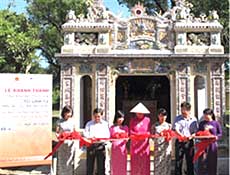Toi Linh Tu (the Highest Celestial) Temple in the Hue Citadel, built in the early 20th century, has been restored with German assistance and is again open to visitors.
 The temple, built during the Nguyen Dynasty (1802-1945), was meant originally for ladies of the royal court.
The temple, built during the Nguyen Dynasty (1802-1945), was meant originally for ladies of the royal court.
Built in the Phu Noi Vu (the Royal Treasury) compound, the Vietnamese ornaments inside and outside attest to the local artistry and craftsmanship though they were also inspired by European architecture.
The restoration was completed on July 19 by the Hue Monuments Conservation Centre and German Conservation Restoration and Education Projects (GCREP).
A group of German experts led by Andrea Teufel, project manager and chief restorer, six students from the Hue College of Arts, and local artisans began the work in July 2011.
War, the elements, and time all inflicted damage on the temple, yet it never ceased to be a place to worship the highest celestial deities.
"Now, thanks to the careful conservation and restoration of its four altars and rich stucco, mosaic and painted decorations, the future of the spiritual monument is assured- and so is public access," the centre said in a press release.
Two major issues - how to conserve and restore the original stucco and mosaic artwork on site, and how to conserve and restore the Long Tho lime-plaster typical of Hue - were resolved during the project.
The findings will be documented to sustain further scientific inquiry and heritage preservation projects in Hue.
Active knowledge transfer - building local capacity through on-the-job training - was also part of the project.
The work was implemented with funding of nearly 91,400 euros (over US$112,000) from the German Government plus counter capital of nearly 7,600 euros from the centre.
German GCREP restorers have been training Vietnamese artists and artisans since 2003.
They will soon work with eight local trainees to conserve and restore the interior of the Ta Vu, the Mandarins' House in the Imperial City.